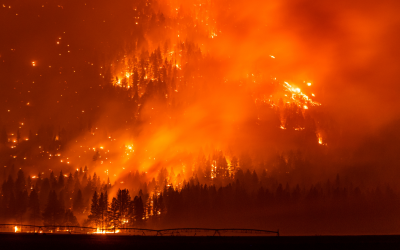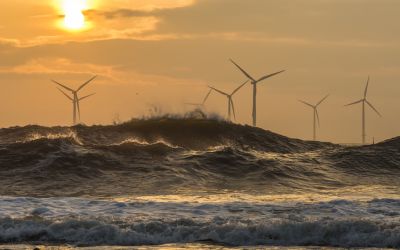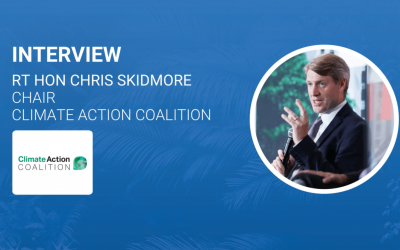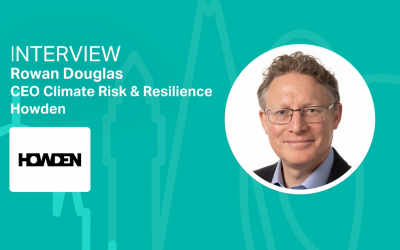Michael Lewis on how food systems are affecting climate change and other systemic risks
Climate Action caught up with Michael Lewis, Head of Research - ESG at DWS to discuss how food systems are affecting climate change and other systemic risk.

Why is DWS Research focusing on forests, land and agriculture as an area of investor interest?
The world’s climate scientists have shown that even our worst estimates of climate scenarios are proving too optimistic[1]. While cutting emissions is the obvious approach, it is not enough. We also need to take care of the natural carbon tanks that exist today: namely our land, forests and oceans. When it comes the Earth’s forests these sequestered about twice as much CO2 as they emitted between 2001 and 2019 absorbing a net 7.6 billion tonnes of CO2 per annum, or one and a half times more carbon than the United States emits annually[2]. However, their role as carbon sequesters is at risk from land use change, climate change and pollution. Consequently, any credible global climate strategy must incorporate nature’s critical role in emission reduction and removal.
How are our food systems affecting climate change and other systemic risks?
The agricultural sector accounts for 70% of the world’s total freshwater withdrawal[3], spurs up to 80% of deforestation[4], causes around 70% of the projected loss of terrestrial biodiversity[5] and is responsible for around 25% of greenhouse gas emissions[6]. It therefore plays an important role in the biogeochemical cycles of carbon, water, nitrogen and phosphorous as well as impacting biodiversity. Agriculture has therefore played a central role in many of the Earth systems’ planetary boundaries to be breached[7], such as land use change and climate change. Consequently, this is moving the Earth outside of its safe operating space and threatens large-scale abrupt or irreversible environmental damage.
Are food systems receiving the investments they require?
Put simply, no. One route to assess investment flows to the biosphere is through the OECD’s SDG financing tracker. This tracker pools bilateral and multilateral aid, or so-called official development assistance. When it comes to financing the Earth systems their latest figures show financial flows to the four SDGs directly related to the biosphere, namely life below water. life on land, clean water and sanitation and climate action are among the least funded of the SDGs, receiving just 13.5% of all SDG funding from development finance[8]. UNCTAD data[9] reveal a similar picture with international investment in food and agriculture declining 35% in 2021 compared to pre-pandemic levels on a project level basis. These illustrate why sizeable private sector resources will be required to complement official development assistance, and why investment flows need to be targeted to the appropriate biosphere and in the geography where it is required.
What recommendations do you have to push a food systems agenda?
The world needs to produce enough food on less land and with fewer emissions. Biodiversity ambition includes not just turning 30% of land and sea into protected areas, putting an end to deforestation and land degradation and reducing pesticide use by 50% but also avoiding food loss and waste, the wider adoption of sustainable agricultural practices, increasing company commitments to science-based nature targets, and the development of an Earth systems’ taxonomy. As a production level, solutions include recycling wastewater, rainwater harvesting, drip irrigation technology, precision planting and hybrid seeds, improved infrastructure and pipes, and the introduction of desalination facilities. Lessons can be learnt from the Netherlands, which after the United States, is the world’s largest exporter of agricultural products by value, despite being 270 times smaller than the U.S.[10]. With greenhouses covering 36 square miles, compared to Manhattan’s 23 square miles, the Netherlands is a powerhouse of precision, high yield, low impact food production[11]. Spreading the adoption of the Netherlands’ greenhouse infrastructure, crop science and agricultural technologies, would help reduce the water and environmental footprint of food production, while coping with growing food demand.
What role do governments and standard setters play?
Over the past few years efforts to protect and restore our natural environment have been ramped up by key stakeholders. At a government level, this is illustrated by the Leaders Pledge for Nature signed in September 2020, which commits 94 heads of state and government, representing 38% of world GDP, to reverse biodiversity loss by 2030[12]. At a financial and corporate level, action includes the Finance for Biodiversity Pledge and the Business for Nature initiative respectively. All eyes are now on global leadership appearing at December’s COP15 biodiversity summit which must be aligned more than ever to COP climate summits This seems possible since COP27 and COP28’s hosts Egypt and the United Arab Emirates have high food import requirements. We also need to see standard setters moving beyond the current efforts on climate and single materiality to one which encompasses broader sustainability issues such as biodiversity loss and water risk and incorporating double materiality.
Important information
DWS is the brand name of DWS Group GmbH & Co. KGaA and its subsidiaries under which they do business. The DWS legal entities offering products or services are specified in the relevant documentation. DWS, through DWS Group GmbH & Co. KGaA, its affiliated companies and its officers and employees (collectively “DWS”) are communicating this document in good faith and on the following basis.
This document is for information/discussion purposes only and does not constitute an offer, recommendation or solicitation to conclude a transaction and should not be treated as investment advice. This document is intended to be a marketing communication, not a financial analysis. Accordingly, it may not comply with legal obligations requiring the impartiality of financial analysis or prohibiting trading prior to the publication of a financial analysis.
This document contains forward looking statements. Forward looking statements include, but are not limited to assumptions, estimates, projections, opinions, models and hypothetical performance analysis. No representation or warranty is made by DWS as to the reasonableness or completeness of such forward looking statements. Past performance is no guarantee of future results.
The information contained in this document is obtained from sources believed to be reliable. DWS does not guarantee the accuracy, completeness or fairness of such information. All third party data is copyrighted by and proprietary to the provider. DWS has no obligation to update, modify or amend this document or to otherwise notify the recipient in the event that any matter stated herein, or any opinion, projection, forecast or estimate set forth herein, changes or subsequently becomes inaccurate.
Investments are subject to various risks. Detailed information on risks is contained in the relevant offering documents.
No liability for any error or omission is accepted by DWS. Opinions and estimates may be changed without notice and involve a number of assumptions which may not prove valid DWS does not give taxation or legal advice. This document may not be reproduced or circulated without DWS’s written authority.
This document is not directed to, or intended for distribution to or use by, any person or entity who is a citizen or resident of or located in any locality, state, country or other jurisdiction, including the United States, where such distribution, publication, availability or use would be contrary to law or regulation or which would subject DWS to any registration or licensing requirement within such jurisdiction not currently met within such jurisdiction. Persons into whose possession this document may come are required to inform themselves of, and to observe, such restrictions.
© 2022 DWS International GmbH, CRC 092987_1.0 November 4th, 2022
Issued in the UK by DWS Investments UK Limited which is authorised and regulated in the UK by the Financial Conduct Authority.
© 2022 DWS Investments UK Limited
In Hong Kong, this document is issued by DWS Investments Hong Kong Limited. The content of this document has not been reviewed by the Securities and Futures Commission.
© 2022 DWS Investments Hong Kong Limited
In Singapore, this document is issued by DWS Investments Singapore Limited. The content of this document has not been reviewed by the Monetary Authority of Singapore.
© 2022 DWS Investments Singapore Limited
In Australia, this document is issued by DWS Investments Australia Limited (ABN: 52 074 599 401) (AFSL 499640). The content of this document has not been reviewed by the Australian Securities and Investments Commission.
© 2022 DWS Investments Australia Limited
Distribution in USA
Investing primarily in investments that meet ESG criteria carries the risk that the strategy may forgo otherwise attractive investment opportunities or increase or decrease its exposure to certain types of companies and, therefore, may underperform funds that do not consider ESG factors. The ESG research and ratings used by DWS are based on information that is publicly available and/or provided by the companies themselves or by third parties and such information may be incomplete, unavailable, or unreliable. Additionally, investors can differ in their views of what constitutes positive or negative ESG characteristics. As a result, the strategy may invest in issuers that do not reflect the beliefs and values with respect to ESG of any particular investor.
While DWS believes that material ESG considerations can be drivers of long-term investment performance, investment strategies that consider ESG factors may perform differently than those in which no ESG factors are applied. The consideration of ESG factors carries the risk that a portfolio may forgo otherwise attractive investment opportunities or increase or decrease its exposure to certain types of issuers or properties and, therefore, may underperform portfolios that do not consider such ESG factors. The ESG research and ratings used by DWS are based on information that is publicly available and/or provided by the companies themselves or by third parties. Such information may be incomplete, unavailable, or unreliable and, with respect to information provided by third parties, may be based on criteria that differ among data providers. The reliability and comparability of the data will affect the proprietary ratings utilized by certain business lines within DWS. Certain ESG ratings utilized by DWS are based on peer group comparisons, which may result in a favorable rating for an issuer that might not have received a favorable rating if compared to a broader universe of issuers. Additionally, investors can differ in their views of what constitutes positive or negative ESG characteristics and DWS’ investment decisions may differ from other’s views. As a result, certain strategies may invest in issuers that do not reflect the beliefs and values with respect to ESG of any particular investor. In addition, there is a risk that the companies or assets identified by an investment strategy that considers ESG factors do not operate as expected as it relates to the ESG considerations. A company or asset’s ESG performance or DWS’ assessment of its ESG performance could vary over time, which could cause a fund or portfolio to be temporarily invested in assets that do not comply with the strategy’s approach towards considering ESG characteristics. Moreover, DWS may change its view of a company or asset’s ESG characteristics over time. While DWS views ESG considerations as drivers of long-term performance, there is no guarantee that pursuing investments with positive ESG characteristics will yield such results.
[1] Nature (August 2021) - Increasing probability of record-shattering climate extremes
[2] Nature (January 2021). Global maps of twenty-first century forest carbon fluxes
[3] World Bank (October 2022). Water in agriculture https://www.worldbank.org/en/topic/water-in-agriculture
[4] Kissinger G., Herold M., De Sy V. (2012). Drivers of deforestation and forest degradation
[5] WWF (2021). Farming with biodiversity
[6] OurWorldInData (March 2021). How much of greenhouse gas emissions come from food?
[7] Stockholm Resilience Centre (April 2022). Freshwater boundary exceeds safe limits
[8] OECD: The SDG financing lab. Data capture top 25 providers of overseas development assistance in 2019
[9] UNCTAD (June 2022). World investment report 2022 (percentage figure relates to number of projects)
[10] National Geographic (September 2017). This tiny country feeds the world
[11] WWAP 2015; EEA 2020
[12] Leaders’ Pledge for Nature (January 2022). 2021: Summary of progress one year on






